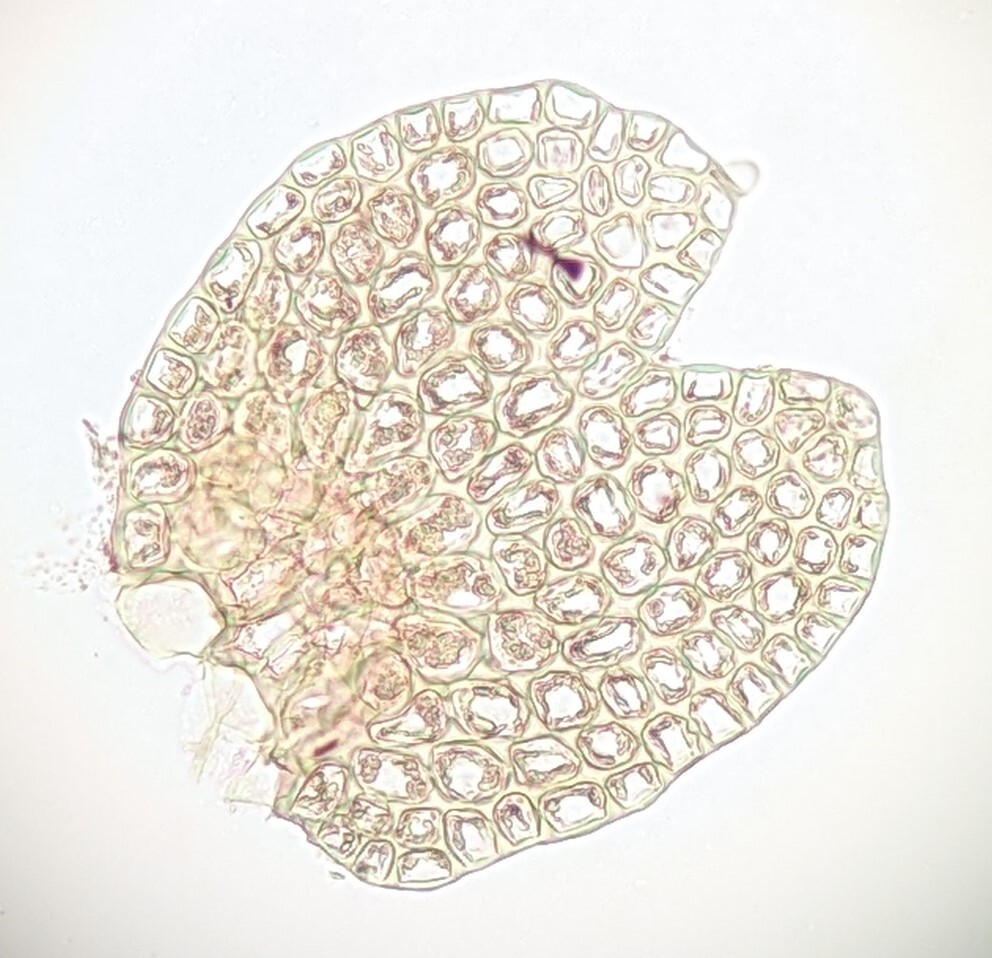Cheilolejeunea
Epiphytic, lithophytic or rarely terrestrial, monoicous (not in Victoria) or dioicous. Asexual reproduction by caducous leaves (not in Victoria), leaf lobes (not in Victoria) or branches (not in Victoria). Stem irregularly branched; branches emerging from main stem near and ventral to an unmodified lateral leaf with a lobed and foliose collar at base. Leaves imbricate to contiguous, spreading flat against substrate or rising away from substrate (not in Victoria), broadly attached to stem; lobe ovate-orbicular to ovate-oblong, entire, crenulate or rarely dentate (not in Victoria), with a rounded to acute or apiculate (not in Victoria) apex; lobule smaller than lobe, ovoid or oblong to rectangular, usually inflated, fused along basiscopic margin to lobe forming an arching keel that does not continue curve of adjoining lobe margin, free along apical margin and plane or incurved, with one or two (not in Victoria) marginal teeth; tooth closest to stem unicellular or multicellular (not in Victoria); tooth furthest from stem usually reduced or absent, when well-developed (not in Victoria) close to second tooth; hyaline papilla on lobule margin between teeth when both well-developed (not in Victoria) or situated at the base of single tooth on side away from stem; cells circular to elongate hexagonal, smooth, mammillose (not in Victoria) or unipapillose (not in Victoria) adaxially, thin- to thick- (not in Victoria) walled, usually with small (not in Victoria) to large and often contiguous trigones, sometimes with intermediate thickenings (not in Victoria), usually with 1–4, rarely 5 (not in Victoria), small and finely granular (not in Victoria) to large ellipsoid and coarsely granular to botryoidal oil bodies, when 1 rarely occupying most of the cell and forming an ocelli (not in Victoria). Underleaves present, one to each pair of lateral leaves, undivided (not in Victoria), shallowly bilobed or lobed to around half the underleaf length, orbicular to oblong in outline, cuneate or auriculate (not in Victoria) at base, distant to imbricate (not in Victoria); lobes entire, rarely dentate (not in Victoria); cells circular, rounded quadrate or elliptic to rectangular, thin- to thick- (not in Victoria) walled, usually with small (not in Victoria) to large and often contiguous trigones. Perianth obovoid to ellipsoid (not in Victoria), 4–5 keeled or terete (not in Victoria), rarely pluriplicate (not in Victoria), without tubercles or teeth, without (not in Victoria) or with a short to long beak.
167 species (Söderström et al. 2016) shared between temperate to tropical regions of the Americas, Africa and Asia to the Pacific; one species, C. mimosa (Hook.f. & Taylor) R.M.Schust., in Victoria.
Söderström, L., Hagborg, A., von Konrat, M., Bartholomew-Began, S., Bell, D., Briscoe, L., Brown, E., Cargill, D.C., Costa, D.P., Crandall-Stotler, B.J., Cooper, E.D., Dauphin, G., Engel, J.J., Feldberg, K., Glenny, D., Gradstein, S.R., He, X., Heinrichs, J., Hentschel, J., Ilkiu-Borges, A.L., Katagiri, T., Konstantinova, N.A., Larraín, J., Long, D.G., Nebel, M., Pócs, T., Puche, F., Reiner-Drehwald, E., Renner, M.A.M., Sass-Gyarmati, A., Schäfer-Verwimp, A., Moragues, J.S., Stotler, R.E., Sukkharak, P., Thiers, B.M., Uribe, J., Váňa, J., Villarreal, J.C., Wigginton, M., Zhang, L. & Zhu, R. (2016). World checklist of hornworts and liverworts. Phytokeys 59: 1–828.
 Spinning
Spinning